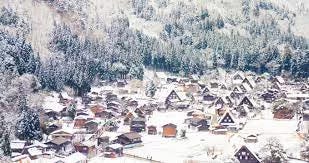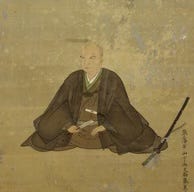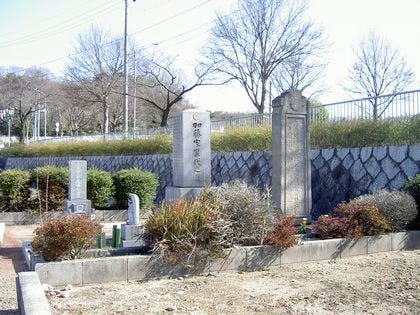Shirakawa-go is a World Heritage Site in Hida City, Gifu Prefecture, known for its village of ancient A-framed gassho-zukuri traditional thatched-roof farmhouses.
One of the best places to see the entire village is from the look-out atop a craggy cliff outlet at the southerm end of the ancient village. This observation deck on the ridge was originally the ruins of a long-abandoned castle once known as Ogimachi Castle.
On May 12, 1568, Yamashita Ujikatsu was born to the regional lord, Yamashita Tokiyoshi at Ogimachi Castle in Shirakawa-go, with the childhood names of Manjumaru, later Hanzaburo, and finally as an adult, Ujikatsu.Although his name may not be familiar, he can be seen as one of the most influential samurai of the late Sengoku, early Edo periods.
The Yamashita clan initially served their relatives, the Uchigashima clan. In the mid-1400s, the Uchigashima clan were transferred to the Shirakawa region at the behest of the Ashikaga Shogunate and came to control the rich mining business there. The Uchigashima clan constructed their base, Kaerikumo Castle, about 6km away from Shirakawa, and built a network of smaller satellite castles around it, including Ogimachi Castle in Shirakawa. Ujikatsu would assume his father’s position as castellan of Ogimachi on his father’s death.
At around 11 O’clock on the night of January 18, 1585, a violent earthquake occurred, causing a massive landslide that buried and destroyed Kaerikumo Castle, the surrounding castle town, its more than 300 houses, residents and the entire Uchigashima clan in seconds. Many of the elite clan’s vassals were at Kaerikumo celebrating New Years, and so they too perished in the avalanche. The exact location of this castle is a mystery, and this has attracted the interest of castle researchers, and also treasure hunters who believe that large amounts of gold were kept at the castle at the time. Recent excavations in the general area revealed little more than long buried cut timbers and the bones of a horse.
Yamashita Ujikatsu, as the lord of Ogimachi Castle in Shirakawa at the time, survived, but having lost his lord and relatives, he pledged his allegiance to Tokugawa Ieyasu, then serving under Toyotomi Hideyoshi, and participated directly under Ieyasu in the Siege of Odawara against the Hojo clan in 1590, serving as the vanguard. He accompanied Ieyasu to Kyushu when Toyotomi Hideyoshi constructed his Hizen Nagoya Castle, to be used as the launching pad for the ill-fated Bunroku-Keicho Korean invasion. Thankfully, neither he, nor Ieyasu were ordered to serve in the Korean campaigns.
Following Hideyoshi's death in 1598, Yamashita Ujikatsu continued to serve the Tokugawa as the nation split into two factions leading to the Battle of Sekigahara in 1600. Ujikatsu was rewarded for his efforts in the decisive battle with a fief in Gamo County, Omi Province (present-day Shiga Prefecture).
In 1602, Tokugawa Ieyasu appointed Ujikatsu as the tutor for his ninth son, Tokugawa Yoshinao, the first feudal lord of Owari Province, based at the former Oda Nobunaga held Owari central Kiyosu Castle. One of the reasons suggested for the commission was because Ujikatsu's wife was the younger sister of Lady Soo-in, Ieyasu's wife and concubine, and Yoshinao's birth mother. (Together they had five sons and three daughters, including his eldest son Ujiyasu, Ujitada, Ujitsugu, Hideuji, and Tokiuji.) Ujikatsu was to be the tutor and advisor to his nephew, the young Lord Yoshinao.
Although Tokugawa Ieyasu had won the Battle of Sekigahara in 1600 and became Shogun, he still did not have complete control over the country. The Toyotomi clan under Hideyoshi’s son and heir, Hideyori, continued to occupy Osaka Castle, and many daimyo based in the Western Provinces who had been defeated at Sekigahara continued their allegiance to the Toyotomi clan. There was a high possibility that war would break out again. As advisor to Lord Yoshinao, Yamashita Ujikatsu realised Kiyosu Castle was positioned in a low-lying area, andwas prone to flooding. There was also the risk that any potential enemy could lay siege to Kiyosu simply by damming the surrounding rivers, and causing it to submerge, bring it down. Although Kiyosu Castle was able to accommodate many Eastern troops just before the Battle of Sekigahara, it was too small for the forces Ieyasu envisioned to launch an all-out attack on Osaka. An alternative was needed.
In 1607, Yamashita Ujikatsu advised Tokugawa Ieyasu to abandon Kiyosu Castle, and build a larger, stronger castle. Ujikatsu also proposed three possible locations. One was Komakiyama, the site of Oda Nobunaga’s former hilltop castle, and where Ieyasu had set up his headquarters during the 1584 Battle of Komaki Nagakute. Another was three kilometers north of the Great Atsuta Shrine, the site of Furuwatari Castle, Nobunaga’s father, Oda Nobuhide’s castle where the 13-year-old Nobunaga underwent his gempuku, coming of age ceremony. Yet another proposed spot was the Oda clan’s by then long abandoned Nagoya Castle site.
Ieyasu chose Nagoya! Yamashita then proposed to move all 60 thousand residents and 67 townships, all 100 temples and shrines of Kiyosu to the new castle town of Nagoya, and this became the Kiyosu Goshi, the great Kiyosu relocation.
Yamashita Ujikatsu continued to live in Nagoya and served the Owari Tokugawa clan and the Shogunate. As an elite samurai of the Owari Domain, he was appointed head of the cavalry division, and helped Lord Yoshinao by unifying the ashigaru foot soldiers and the teppotai matchlock gun corps. He was also highly recognized for his achievements during the 1615 Summer Siege of Osaka, and was the only samurai participant of the Owari domain to receive an additional 500 koku reward for his services directly from Tokugawa Ieyasu. He served as general magistrate of Owari from 1616, rising the role of chief magistrate in 1621, and head of the Oyoriai study group in 1622. During 1630 he suffered from an eye disease through which he became blinded, and so he handed control of the clan to his son Ujiyasu, retired, shaved his head, and took the Buddhist name of Michichi.
Ujikatsu died around 24 years later on January 8, 1654, at the age of 85, a very old age for a Sengoku warrior. He had lived a very interesting and influential life.
Often it is not the most well-known of samurai who had the greatest of influence or made the biggest changes in history. Sometimes it was the silent achievers, the ones who served their masters to the best of their abilities who made the nation great.






